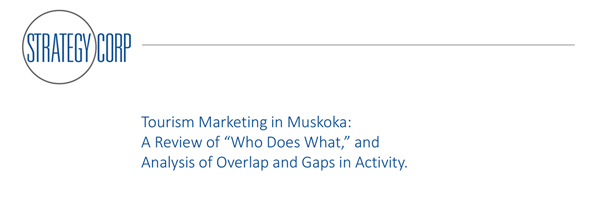
Tourism Marketing In Muskoka
A Review of “Who Does What,” and Analysis of Overlap and Gaps in Activity
The Purpose of the Report was to identify opportunities to:
- Articulate tourism stakeholder priorities
- Identify service gaps and unnecessary overlaps in effort
- Identify opportunities for streamlining and improved collaboration
In preparation of this Report, Strategy Corp:
- Conducted 10 interviews
- Led a half-day workshop of the Steering Committee
- Received and reviewed written feedback on the draft report.
SCI also reviewed the following sources:
- Survey responses from the tourism stakeholder organizations that responded to the survey;
- Stakeholder organizations’ websites and strategic/operational plans; and
- Discovering Ontario: A Report on the Future of Tourism.
NB: Due to limitations in the scope of this project, it is limited to inputs from tourism AGENCY stakeholders. The important perspective of tourism operators that rely on the work of these agencies was beyond the scope of this project.
Executive Summary
- StrategyCorp was hired to assist Muskoka tourism stakeholders prepare for a Tourism Summit. Our mandate was to review “who does what” and to identify gaps, as well as overlap and duplication.
- Following an analysis of stakeholder survey responses, and a series of interviews, a half-day workshop was held with the Steering Committee to discuss preliminary findings. The Draft report was then circulated to study sponsors to allow an opportunity for further input. Based on this process, we observe as follows:
- All participants expressed concern that with limited resources, it is essential to get best value for money.
- The greatest gap is the lack of a cohesive brand for the District of Muskoka.
- MTMA appears to be best suited to lead in the process that will create and manage this brand.
- MTMA is willing to accept this role with renewed vigour, but it will not succeed without active engagement and buy-in from other partners. Collaboration, and improved communication, will be key to this process.
- Agencies would benefit from agreed upon Key Performance Indicators to allow for performance measurement.
- There appears to be less overlap of effort between stakeholders than initially anticipated by sponsors.
- There is an opportunity for streamlining visitor facing communications, including visitor centres and web and print materials.
- Ongoing improved communications among stakeholders will be vital to improving marketing efforts and providing a cohesive Muskoka experience going forward.
Recommendations
It is recommended that Muskoka tourism stakeholder partners focus to start on developing shared solutions to the following three fundamental areas:
- Collaborative Strategy: MTMA lead in the collaborative development of a shared, Muskoka-wide tourism marketing strategy that sets out core directions, priorities, key markets and demographics, initiatives and investments to be supported by all stakeholders.
- Partnerships: There is opportunity to achieve greater success through partnerships that build economies of scale and scope. Partnerships need to be a core competency of all tourism stakeholder organizations.
- Eliminating Overlap and Duplication in the Customer Experience: Streamline and differentiate information and services being offered to potential customers, with a focus on visitor centres, print and web materials, as and when possible.
- Performance Measurement: Develop and agree to a framework of shared Key Performance Indicators to allow all partners a common means of communicating their relative role and results in executing on the shared tourism strategy.






